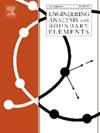计算瞬态热传导边界积分方程域积分的对偶距离变换
IF 4.2
2区 工程技术
Q1 ENGINEERING, MULTIDISCIPLINARY
Engineering Analysis with Boundary Elements
Pub Date : 2025-02-01
DOI:10.1016/j.enganabound.2024.106103
引用次数: 0
摘要
区域积分的精确计算对于瞬态热传导问题的有效边界元分析至关重要。时间步长的逐步减小会导致积分内的时变核快速振荡并呈现近奇异性。此外,在大角度、大边长比的次三角形单元上的积分会导致周向近奇点。传统的距离变换技术虽然有效,但仅限于近奇异积分,并且只能处理一个方向上的近奇异积分。为了提高域积分计算的精度,引入了对偶距离变换方法。首先采用(α, β)坐标变换分离近奇点。然后提出了一种适当的距离变换来消除与变量α相关的近奇异性。进一步分析了形状较差的子三角形引起的周向近奇点。考虑到与变量β相关的积分形式,最后建立了另一种新的距离变换,以减轻单元形状的影响。采用对偶距离变换方法,可以精确地计算出不同时间步长和不同源点位置的域积分。通过数值算例,有效地证明了该方法的准确性和有效性。本文章由计算机程序翻译,如有差异,请以英文原文为准。
Dual distance transformations for evaluating domain integrals in the boundary integral equation of transient heat conduction
Accurate computation of domain integrals is indeed crucial for effective boundary element analysis of transient heat conduction problems. The progressive reduction of the time step can cause the time-dependent kernel within the integral to oscillate rapidly and exhibit near-singularity. Additionally, integration over the sub-triangular element with a large angle and large side length ratio will result in the circumferential near-singularity. The traditional distance transformation technique, while effective, is limited to the nearly singular integrals and addresses the near-singularity in only one direction. To enhance the accuracy of the domain integral computations, a dual distance transformations method is introduced. The (α, β) coordinate transformation is initially employed to separate the near-singularity. An appropriate distance transformation is then proposed to eliminate the near-singularity associated with the variable α. Furthermore, the circumferential near-singularity induced by the sub-triangle with poor shape is analyzed. Considering the integral form related to the variable β, another new distance transformation is finally established to mitigate the effect of the element shape. With the presented dual distance transformations method, the domain integrals can be accurately computed for different time steps and source point locations. The accuracy and efficiency of the proposed method are effectively proven through several numerical examples.
求助全文
通过发布文献求助,成功后即可免费获取论文全文。
去求助
来源期刊

Engineering Analysis with Boundary Elements
工程技术-工程:综合
CiteScore
5.50
自引率
18.20%
发文量
368
审稿时长
56 days
期刊介绍:
This journal is specifically dedicated to the dissemination of the latest developments of new engineering analysis techniques using boundary elements and other mesh reduction methods.
Boundary element (BEM) and mesh reduction methods (MRM) are very active areas of research with the techniques being applied to solve increasingly complex problems. The journal stresses the importance of these applications as well as their computational aspects, reliability and robustness.
The main criteria for publication will be the originality of the work being reported, its potential usefulness and applications of the methods to new fields.
In addition to regular issues, the journal publishes a series of special issues dealing with specific areas of current research.
The journal has, for many years, provided a channel of communication between academics and industrial researchers working in mesh reduction methods
Fields Covered:
• Boundary Element Methods (BEM)
• Mesh Reduction Methods (MRM)
• Meshless Methods
• Integral Equations
• Applications of BEM/MRM in Engineering
• Numerical Methods related to BEM/MRM
• Computational Techniques
• Combination of Different Methods
• Advanced Formulations.
 求助内容:
求助内容: 应助结果提醒方式:
应助结果提醒方式:


